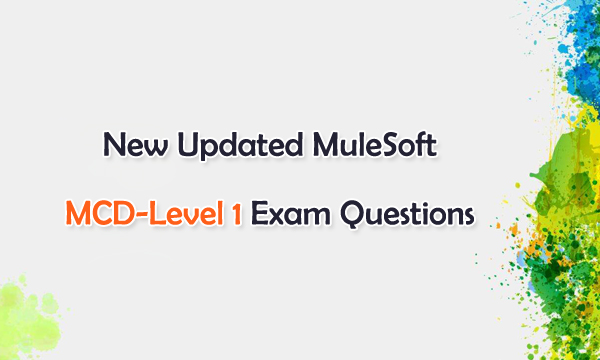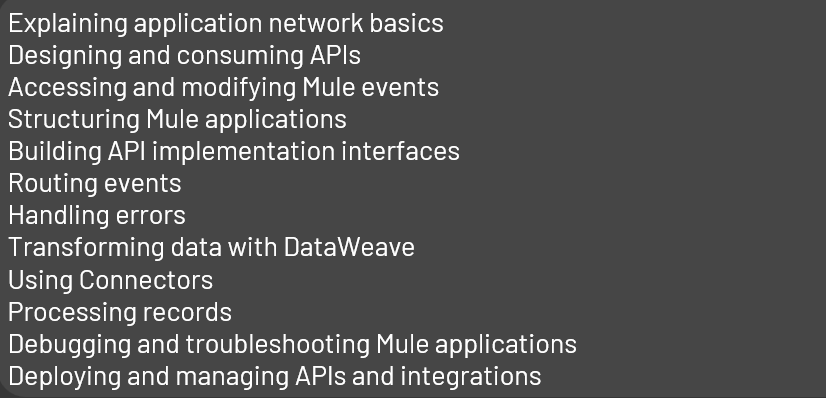New Updated MuleSoft MCD-Level 1 Exam Questions
December 25,2021 02:07 AM
MuleSoft Certified Developer - Level 1 (Mule 4) MCD-Level 1 exam questions have been updated, which contain 210 Q&As. The MCD-Level 1 (Mule 4) exam validates that a developer has the required knowledge and skills to design, build, test and debug, deploy, and manage basic APIs and integrations: moving from Anypoint Platform to Anypoint Studio and back. With the updated MuleSoft certification MCD-Level 1 exam questions, you can pass the test in a short time.

MuleSoft MCD-Level 1 Exam
MuleSoft certification MCD-Level 1 exam information is the first step for you to understand the test.

MCD-Level 1 MuleSoft Exam Topics
MuleSoft MCD-Level 1 exam topics cover the following details.

Practice Updated MCD-Level 1 Exam Questions
To test the above MuleSoft certification MCD-Level 1 exam topics, the updated MuleSoft Certified Developer - Level 1 (Mule 4) MCD-Level 1 exam questions are the best guides. Share some updated MuleSoft MCD-Level 1 exam questions and answers below.
1.An app team is developing a mobile banking app. It took them two months to create their own APIs to access transaction information from a central database. The app team later found out that another team had already built an API that accesses the transaction information they need. According to MuleSoft, what organization structure could have saved the app team two months of development time?
A. Center of Excellence
B. Center for Enablement
C. MuleSoft Support Center
D. Central API Review Board
Answer: B
2.According to MuleSoft, what is the Center for Enablement’s role in the new IT operating model?
A. Implements line of business projects to enforce common security requirements
B. Creates and manages discoverable assets to be consumed by line of business developers
C. Centrally manages partners and consultants to implement line of business projects
D. Implements line of business projects to enforce common security requirements
Answer: B
3.An API has been created in Design Center. What is the next step to make the API discoverable?
A. Publish the API to Anypoint Exchange
B. Publish the API from inside flow designer
C. Deploy the API to a Maven repository
D. Enable autodiscovery in API Manager
Answer: A
4.An API implementation has been deployed to CloudHub and now needs to be governed. IT will not allocate additional vCore for a new Mule application to act as an API proxy. What is the next step to preseive the current vCore usage, but still allow the Mule application to be managed by API Manager?
A. Register the same API implementation in Runtime Manager to connect to API Manager
B. Modify the API implementation to use auto-discovery to register with API Manager
C. Upload the Mule application's JAR file to the API instance in API Manager
D. Deploy the same API implementation behind a VPC and configure the VPC to connect to API Manager
Answer: B
5.A flow needs to combine and return data from two different data sources. It contains a Database SELECT operation followed by an HTTP Request operation. What is the method to capture both payloads so the payload from the second request does not overwrite that from the first?
A. Put the Database SELECT operation inside a Cache scope
B. Put the Database SELECT operation inside a Message Enricher scope
C. Nothing, previous payloads are combined into the next payload
D. Save the payload from the Database SELECT operation to a variable
Answer: D
MCD-Level 1 Exam Dumps PDF & SOFT | 1 Year Free Update | Money Back Guarantee
- Related Suggestion
- MuleSoft Certified Developer - Level 2 Certification Info June 28,2023
- MCIA-Level 1 MuleSoft Certified Integration Architect-Level 1 Updated Dumps May 19,2021
- MuleSoft MCD Level 1 Delta Exam Dumps December 12,2020
- MuleSoft Certified Platform Architect-Level 1 Dumps Questions February 01,2020
- MuleSoft Certified Developer-Level 1 Exam Dumps December 14,2019

